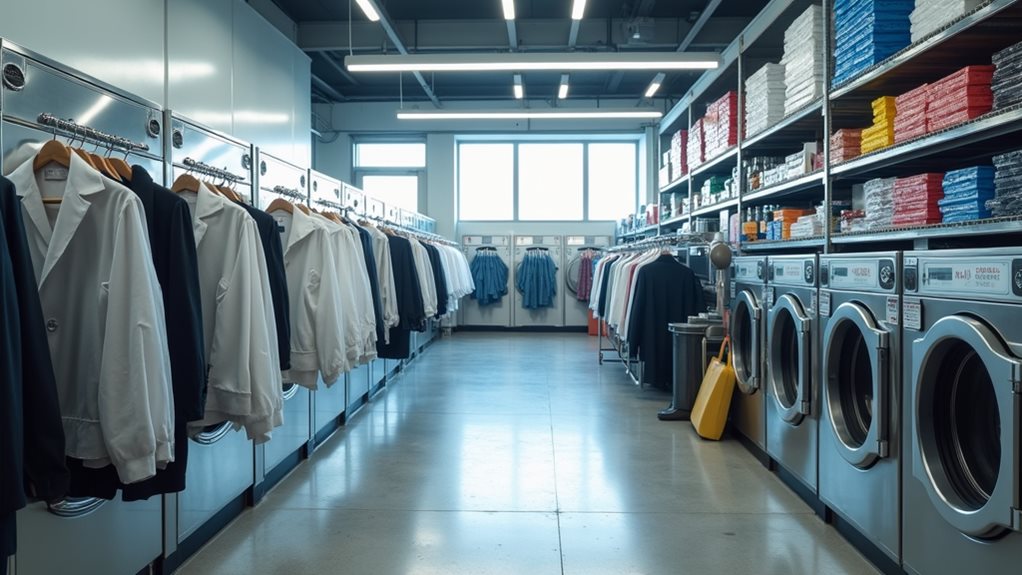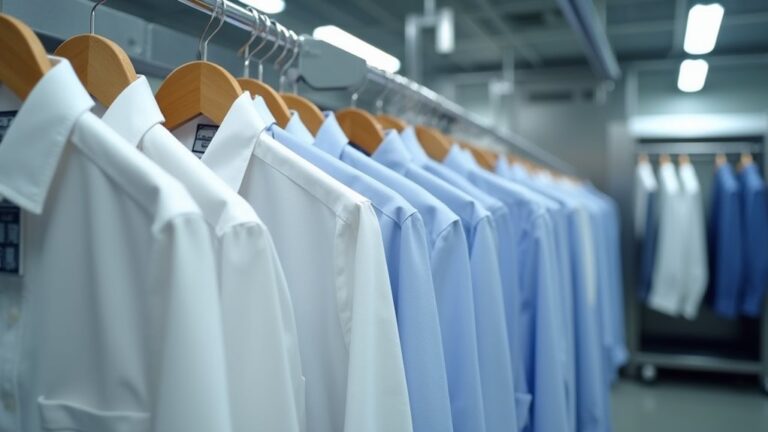You’ll find that dry cleaning businesses can indeed be profitable ventures, with successful operations typically generating net profit margins between 10% to 25% and monthly revenues ranging from $3,000 to $30,000, though your success depends heavily on location, customer base, and how well you manage the delicate balance between premium pricing and operational costs. The secret lies in understanding that while you’ll need to process around 2,000 pieces monthly just to break even, the right neighborhood and service mix can transform this challenge into a rewarding opportunity.
Revenue Streams and Pricing Structure of Dry Cleaning Businesses
When I first considered opening a dry cleaning business years ago, I’ll admit I was pretty naive about how these operations actually generate their income, thinking it was just a simple “wash and charge” model like doing laundry at home.
Boy, was I wrong! The pricing structure actually involves multiple revenue streams that work together beautifully.
You’ll charge $3-7 for basic shirts and pants, while suits and dresses bring in $10-20 each. Those bulky comforters? They’re your goldmine at $15-30 per item.
Don’t overlook additional dry cleaning services like stain removal and pressing, which add $2-5 to each transaction.
Smart operators also offer subscription packages for regular customers, creating predictable monthly income while building loyalty through discounted rates.
Specialized services like wedding dress cleaning or leather treatment command premium pricing and can significantly boost your profit margins compared to standard garment cleaning.
Customer Base and Spending Patterns in the Dry Cleaning Industry

Understanding your pricing strategy means absolutely nothing if you don’t know who’s actually walking through your doors and how much they’re willing to spend, which is exactly the lesson I learned during my second month of operation when I realized I’d been completely guessing about my customer demographics.
Your customers typically fall into two camps: individuals spending $20-50 per visit monthly, and business clients with higher-volume needs.
Customer habits vary dramatically between urban locations (averaging $10,000 monthly revenue) versus small towns ($2,000).
Smart operators track spending patterns religiously, noting that annual customer contributions range from $240-2400, with $1000-1200 being average.
Customer satisfaction improves when you offer subscription packages, creating predictable revenue while giving clients discounted rates on regular services.
Established businesses in affluent neighborhoods often command premium pricing due to customers’ higher disposable income and willingness to pay for quality garment care services.
Operating Expenses and Cost Management Strategies

You’ll quickly discover that running a dry cleaning business means juggling multiple operating expenses that can either make or break your profitability.
From the obvious costs like chemical solvents and equipment maintenance to the sneaky ones like utility bills that seem to multiply faster than laundry piles during wedding season.
I learned this lesson the hard way when I watched a friend’s cleaning business struggle because he focused only on revenue while his expenses quietly devoured his profits like moths in a wool suit.
The key to survival lies in understanding exactly where your money goes each month, then implementing smart cost reduction strategies that don’t compromise the quality your customers expect.
These major expenses – including equipment costs, rent, labor, and chemical supplies – heavily influence whether your business will achieve the typical 10-20% net profit margins that successful dry cleaning operations maintain.
Major Operating Expenses
Five major expense categories will either make or break your dry cleaning venture, and I learned this lesson the hard way when my friend Sarah opened her first location in downtown Portland.
Your chemical solvents, cleaning equipment, rent, staff wages, and utilities create the foundation of your operating expenses, directly impacting profitability in ways you mightn’t expect.
Sarah’s utility costs alone ate up 15% of her monthly revenue because she hadn’t researched energy-efficient equipment beforehand – ouch! 😅
The chemical solvents proved surprisingly expensive, especially the eco-friendly options her customers demanded.
Staff wages became her largest expense category, while equipment maintenance costs caught her completely off-guard.
Beyond these ongoing expenses, smart operators also maintain adequate working capital to cover the first few months of operation while building their customer base.
Understanding these five pillars helps you budget realistically and avoid the financial surprises that derail promising ventures.
Cost Reduction Strategies
Smart cost management transforms those intimidating expense categories into manageable, controllable elements of your business, and I’ve watched countless dry cleaning owners turn their financial situations around by implementing just a few strategic changes.
You’ll discover that negotiating with suppliers for better chemical solvent rates often yields immediate savings—I’ve seen owners reduce their chemical costs by 15-20% simply by asking for volume discounts or switching suppliers.
Installing energy-efficient equipment might require upfront investment, but your utility bills will thank you monthly.
Streamlining workflows eliminates wasted labor hours, directly boosting your profit margins.
Regular equipment maintenance prevents those heart-stopping repair bills that can devastate your monthly budget.
Smart inventory tracking stops money from literally going down the drain through waste and overordering.
Understanding geographic location pricing differences can help you competitively position your services while maintaining healthy profit margins, especially since urban dry cleaners typically charge 20-40% more than suburban locations.
These cost management strategies transform operating expenses from budget-busters into controlled, predictable numbers.
Profit Margins and Financial Performance Metrics

When I first looked at dry cleaning financials, I’ll admit I was confused by the difference between gross margins (30-50%) and net margins (10-25%) – but understanding these numbers became my compass for measuring real profitability.
You’ll want to track your monthly revenue benchmarks closely, because there’s a massive gap between struggling at $600 per month and thriving at $15,000, with most solid operations hitting around $3,000 monthly.
The breakeven analysis really opened my eyes though, since you’ll need to process roughly 2,000 pieces each month just to cover your $10,000 in fixed expenses, which means every garment beyond that point starts padding your actual profit.
Small independent shops typically achieve annual revenues between $200,000 to $500,000, while successful operations in premium locations can reach $1 million or more depending on their market positioning.
Gross Vs Net Margins
Understanding the financial heartbeat of your dry cleaning business means grasping the critical difference between gross and net margins, two numbers that’ll either make you smile at your bank statement or keep you awake at night wondering where all the money went.
Your gross margins, typically ranging from 30% to 50%, show what’s left after direct cleaning costs—think chemicals, utilities, and labor directly tied to processing garments.
Meanwhile, your net margins, averaging 10% to 25%, reveal true profitability after rent, insurance, marketing, and those surprise equipment repairs that always seem to happen at the worst possible moment 😅.
This distinction matters because strong gross margins indicate operational efficiency, while healthy net margins determine whether you’re actually building wealth or just staying busy.
Smart operators boost their bottom line by offering specialty services like alterations, leather cleaning, and premium garment care that command higher prices and improve overall profitability.
Monthly Revenue Benchmarks
Three crucial revenue tiers separate struggling dry cleaners from thriving ones, and knowing exactly where your business falls determines whether you’re building a sustainable enterprise or fighting an uphill battle against mounting expenses.
Small-town operators typically generate $2,000-$8,000 monthly, which honestly feels like treading water while paying rent and utilities.
Mid-tier businesses in suburban areas hit $8,000-$15,000, where you’ll start breathing easier and maybe even sleeping through the night.
High-end metropolitan dry cleaning business locations can reach $30,000 monthly when you’ve mastered customer service and positioned yourself strategically.
These monthly revenue benchmarks aren’t just numbers on paper—they represent real families paying mortgages, sending kids to college, and building legacies that’ll outlast pressed shirts and hemmed pants.
However, achieving sustainable profitability requires maintaining profit margins between 15-25% after covering equipment costs, chemical supplies, labor, rent, and utilities across all revenue tiers.
Breakeven Point Analysis
Since most dry cleaning owners I’ve met over the years seem genuinely surprised when I mention that servicing 2,000 pieces monthly represents their magic breakeven number, let me walk you through the financial reality that’ll either make or break your business dreams.
Your breakeven point sits at roughly $10,000 in fixed monthly expenses, which means you’ll need to process those 2,000 garments just to keep the lights on.
Here’s where profitability gets interesting though – once you surpass this threshold, every additional piece becomes pure profit potential.
Smart dry cleaning businesses understand that this breakeven analysis isn’t just accounting mumbo-jumbo; it’s your roadmap to financial freedom, showing exactly when you’ll shift from survival mode to actually building wealth.
The industry typically sees net profit margins ranging from 15% to 25%, which means once you exceed your breakeven threshold, you can expect solid returns on every dollar of additional revenue generated.
Breakeven Analysis and Path to Profitability

When I first started analyzing dry cleaning businesses, I was shocked to discover that breaking even requires servicing around 2,000 pieces monthly—that’s roughly 67 garments every single day, which seemed overwhelming until I realized this translates to covering those pesky fixed expenses of about $10,000 per month.
Breaking even in dry cleaning means processing 67 garments daily just to cover your $10,000 monthly fixed costs—shocking but manageable.
Your breakeven analysis becomes the foundation of your entire business model, and honestly, it’s where most newcomers stumble.
You’ll need to understand that profitability kicks in once you’ve crossed that 2,000-piece threshold, with gross margins between 30-50% becoming your sweet spot.
The path forward isn’t complicated—focus on controlling utility costs, negotiating vendor contracts, and crafting a rock-solid business plan that clearly defines your services and pricing structure.
Well-managed operations typically achieve profit margins ranging from 15-25%, with urban locations serving affluent neighborhoods consistently outperforming their rural counterparts.
Trust me, these fundamentals make all the difference.
Market Size and Growth Potential for Dry Cleaning Services

Looking at the numbers behind this industry absolutely blew my mind—we’re talking about a $69.3 billion market that’s growing at 7% annually through 2030, which means there’s serious money flowing through washing machines and pressing equipment across the globe.
The dry cleaning market size represents significant growth potential that most people overlook, probably because they’re too busy dropping off wrinkled shirts to notice the empire being built around them.
What really gets me excited is how this isn’t some saturated corporate battlefield—it’s mostly small operations, which creates massive opportunities for savvy entrepreneurs who understand efficiency and customer service.
You’re fundamentally looking at an industry where smart operators can capture disproportionate market share simply by doing things better than the mom-and-pop shop down the street.
Franchise Vs Independent Business Models and Earnings Comparison

While I’ve spent countless hours analyzing business models across industries, the franchise versus independent debate in dry cleaning hits differently because the numbers tell such a compelling story about risk versus reward.
When you’re doing an earnings comparison, franchises like ZIPS consistently outperform with AUVs exceeding $1.1 million, while independent dry cleaning operations swing wildly from $2,000 monthly in small towns to $30,000 in upscale metros.
Here’s what I’ve learned: franchise models give you that safety net of proven systems, thorough training, and faster breakeven points, but you’ll pay for that security.
Independent ventures offer creative freedom and potentially lower startup costs, though you’re fundamentally building your airplane while flying it.
The trade-off? Stability versus autonomy.
Factors That Maximize Dry Cleaning Business Profitability

Beyond choosing between franchise security and independent freedom, the real magic happens when you start implementing specific strategies that can transform a struggling dry cleaner into a profit powerhouse.
Location’s everything – I’ve watched businesses thrive in affluent neighborhoods while identical operations struggled in poor spots.
You’ll want to diversify your services offered beyond basic cleaning; adding alterations and wash-and-fold can boost customer retention greatly.
Smart cost management, like negotiating supplier deals, keeps those 10-25% profit margins healthy.
Consider subscription models for regular customers – they’ll spend $1,000-$1,200 annually when committed.
Most importantly, consistent quality service builds the loyalty that separates successful dry cleaning operations from those barely surviving in this competitive market.




